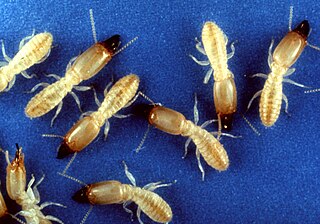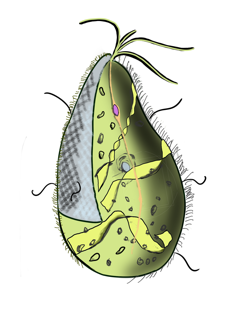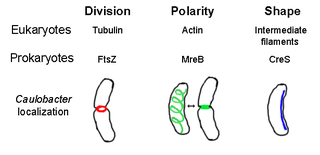
Treponema pallidum, formerly known as Spirochaeta pallida, is a spirochaete bacterium with various subspecies that cause the diseases syphilis, bejel, and yaws. It is transmitted only among humans. It is a helically coiled microorganism usually 6–15 μm long and 0.1–0.2 μm wide. T. pallidum's lack of either a tricarboxylic acid cycle or oxidative phosphorylation results in minimal metabolic activity. The treponemes have a cytoplasmic and an outer membrane. Using light microscopy, treponemes are visible only by using dark field illumination. Treponema pallidum consists of three subspecies, T. p. pallidum, T. p. endemicum, and T. p. pertenue, each of which has a distinct associated disease.

A spirochaete or spirochete is a member of the phylum Spirochaetota, which contains distinctive diderm (double-membrane) gram-negative bacteria, most of which have long, helically coiled cells. Spirochaetes are chemoheterotrophic in nature, with lengths between 3 and 500 μm and diameters around 0.09 to at least 3 μm.

Reticulitermes flavipes, the eastern subterranean termite, is the most common termite found in North America. These termites are the most economically important wood destroying insects in the United States and are classified as pests. They feed on cellulose material such as the structural wood in buildings, wooden fixtures, paper, books, and cotton. A mature colony can range from 20,000 workers to as high as 5 million workers and the primary queen of the colony lays 5,000 to 10,000 eggs per year to add to this total.

Mixotricha paradoxa is a species of protozoan that lives inside the gut of the Australian termite species Mastotermes darwiniensis.
Treponema denticola is a Gram-negative, obligate anaerobic, motile and highly proteolytic spirochete bacterium. It is one of four species of oral spirochetes to be reliably cultured, the others being Treponema pectinovorum, Treponema socranskii and Treponema vincentii. T. denticola dwells in a complex and diverse microbial community within the oral cavity and is highly specialized to survive in this environment. T. denticola is associated with the incidence and severity of human periodontal disease. Treponema denticola is one of three bacteria that form the Red Complex, the other two being Porphyromonas gingivalis and Tannerella forsythia. Together they form the major virulent pathogens that cause chronic periodontitis. Having elevated T. denticola levels in the mouth is considered one of the main etiological agents of periodontitis. T. denticola is related to the syphilis-causing obligate human pathogen, Treponema pallidum subsp. pallidum. It has also been isolated from women with bacterial vaginosis.

The prokaryotic cytoskeleton is the collective name for all structural filaments in prokaryotes. It was once thought that prokaryotic cells did not possess cytoskeletons, but advances in visualization technology and structure determination led to the discovery of filaments in these cells in the early 1990s. Not only have analogues for all major cytoskeletal proteins in eukaryotes been found in prokaryotes, cytoskeletal proteins with no known eukaryotic homologues have also been discovered. Cytoskeletal elements play essential roles in cell division, protection, shape determination, and polarity determination in various prokaryotes.

Bacterial phyla constitute the major lineages of the domain Bacteria. While the exact definition of a bacterial phylum is debated, a popular definition is that a bacterial phylum is a monophyletic lineage of bacteria whose 16S rRNA genes share a pairwise sequence identity of ~75% or less with those of the members of other bacterial phyla.
Brachyspira pilosicoli is a gram-negative, anaerobic, host-associated spirochete that colonizes the intestinal tract of animals and humans. It appears as a characteristic "false brush border" due to its end-on attachment to enterocytes of the colon where it interferes with intestinal absorption. B. pilosicoli is unique from other Brachyspira species because it colonizes a variety of domestic animals including pigs, chickens, dogs, wild birds, rodents, and humans. It is the causative agent of intestinal spirochetosis in pigs, chickens and humans. In particular, B. pilosicoli has been described as an important colonic pathogen of pigs and chickens, causing colitis and diarrhea resulting in depressed rates of growth and impaired production on farms where infections with B. pilosicoli may be endemic. Bacterial attachment disrupts the colonic enterocytes and associated villi, causing the symptoms characteristic of intestinal spirochetosis. Additionally, B. pilosicoli is associated with clinical disease in human infections where it has implications for public health.
There are several models of the Branching order of bacterial phyla, one of these was proposed in 1987 paper by Carl Woese.
Methanobrevibacter cuticularis is a species of methanogen archaeon. It was first isolated from the hindgut of the termite Reticulitermes flavipes. It is rod-shaped, ranging in size from 0.34 to 1.6 µm and possesses polar fibers. Its morphology, gram-positive staining reaction, resistance to cell lysis by chemical agents and narrow range of utilizable substrates are typical of species belonging to the family Methanobacteriaceae. It habitates on or near the hindgut epithelium and also attached to filamentous prokaryotes associated with the gut wall. It is one of the predominant gut biota.
Methanobrevibacter woesei is a species of methanogen archaeon, named after Carl R. Woese.
Borrelia turdi, formerly known as Borrelia turdae, is a spirochete bacterium first isolated from specimens of Ixodes tanuki. Its name refers to its reservoir, Turdus merula.
Treponema bryantii is a species of spirochete bacteria within the genus Treponema. This species is an obligate anaerobe and is found in the rumen of cows.
Treponema primitia is a bacterium, the first termite gut spirochete to be isolated, together with Treponema azotonutricium.
Treponema isoptericolens is a spirochaete from the hindgut of the termite Incisitermes tabogae. Its cells are motile, helical in shape, 0.4–0.5 μm in diameter and generally 12–20 μm long; it is obligately anaerobic, with type strain SPIT5T.
Clevelandina reticulitermitidis is a species of spirochete that is symbiotic in wood-eating cockroaches and termites, the type species of its genus.
Treponema socranskii was isolated from gum swabs of people with periodontitis and clinically-induced periodontitis. It is a motile, helically coiled, obligate anaerobe that grows best at 37 °C, and is a novel member of its genus because of its ability to ferment molecules that other Treponema species cannot. T. socranskii’s growth is positively correlated with gingival inflammation, which indicates that it is a leading cause of gingivitis and periodontitis.
Roseomonas is a genus of Gram negative bacteria. The cells are coccoid rods when viewed microscopically. Certain species are known to be opportunistic infections for humans.
Treponema succinifaciens is an anaerobic spirochete bacterium first discovered in the intestines of swine in 1981. The helical cells of T. succinifaciens grow to 16 μm in length and often form chains of cells when cultured. T. succinifaciens is gram-negative and non spore-forming.

The Treponemataceae are a family of spirochete bacteria. The clade includes a number of significant pathogens, such as Treponemapallidum, the cause of human syphilis.





